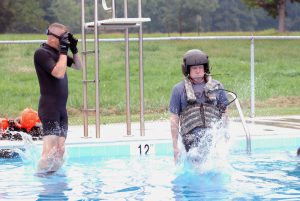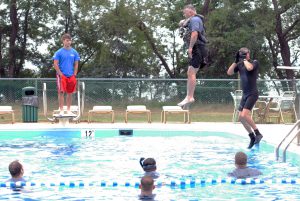Aviators stay afloat during water survival training
[vc_row][vc_column][vc_single_image image=”1652″ img_size=”full” alignment=”center” css_animation=”fadeIn”][vc_column_text css_animation=”fadeIn” css=”.vc_custom_1500493918122{margin: 0px !important;border-width: 0px !important;padding: 0px !important;}”]Sgt. Aimee Fujikawa 29th Mobile Public Affairs Detachment[/vc_column_text][/vc_column][/vc_row][vc_row][vc_column][vc_column_text css_animation=”fadeIn” css=”.vc_custom_1500493955182{margin-top: 0px !important;margin-right: 0px !important;margin-bottom: 1px !important;margin-left: 0px !important;border-top-width: 0px !important;border-right-width: 0px !important;border-bottom-width: 1px !important;border-left-width: 0px !important;padding-top: 0px !important;padding-right: 0px !important;padding-bottom: 1px !important;padding-left: 0px !important;}”]Pilots, flight engineers and crew chiefs took advantage of the final days of summer and went from the hangar to the pool for shallow water training. Maryland Army National Guard flight crews participated in Survival Egress Air training Aug. 28, 2013, at Aberdeen Proving Ground, Edgewood Area, military base pool near Edgewood, Md.
Each aviator practiced underwater techniques to simulate escaping from a submerged aircraft. Participants securely fasten their safety harness, then the crewmember signals the instructors a “thumbs-up” when ready. The chair starts to churn, then is flipped over on its side until it is capsized. Trainers hold the frame stable while the underwater egress is in progress.
The exercise is similar to the Humvee Egress Assistance Trainer and intentionally causes passengers to become disoriented. The SEA also incorporates using a breathing apparatus.
Chief Warrant Officer 2 Erik Clark, Charlie Company, 1st Battalion, 169th Aviation Regiment (Medical Evacuation) said, “The most difficult part of this exercise is keeping reference. Being under water upside down is always the tricky part.”
While it is uncommon for aviators to conduct training in water, this exercise is critically important to each individual’s survival and escape from an emergency water landing.
“They don’t get to do this on a normal basis, so we try to do it annually,” said SEA Instructor, Chief Warrant Officer 5 David Eppler, Headquarters and Headquarters Co. 29th Combat Aviation Brigade.
 Missions over water require additional gear, making the safe exit of a sinking aircraft more difficult.
Missions over water require additional gear, making the safe exit of a sinking aircraft more difficult.
 Once the crewmember is free, he or she ascends from the aircraft, and inflates water wings, which are flotation devices integrated with their gear. According to Eppler, the water wings will maintain positive buoyancy, even with the weight of their flight gear.
Once the crewmember is free, he or she ascends from the aircraft, and inflates water wings, which are flotation devices integrated with their gear. According to Eppler, the water wings will maintain positive buoyancy, even with the weight of their flight gear.
“This training is a confidence builder. All new aviators will have received this training one time before they leave [flight] school, but it’s one of those things that by actually doing it, you’ll feel secure that your gear will work when you go out there,” said Eppler.
Clarke, who had completed this exercise twice before, said, “It’s something you want to do periodically to stay fresh on emergency procedures. It puts what might happen in your mind, and you’re thinking about it prior to any mission over water.”
“Safety is a priority, and for this training, it is mandatory that we have a lifeguard on station and two instructors in the pool at all times,” Eppler said.
Instructors submerge with the crewmember, maintaining a watchful eye and ensuring that each participant follows the proper procedures.
Eppler added, “One hand must remain in contact with the airframe until they actually leave the aircraft, and the training harness is equipped with quick release pull that disengages the harness.”
The day’s training consisted of three sessions, with a maximum of 10 attendees per session. This training is mandatory for Weide facility personnel flying on over-water missions and there will be additional training for those who were unable to attend.[/vc_column_text][vc_raw_html css=”.vc_custom_1500493969312{margin-top: 1px !important;border-top-width: 1px !important;padding-top: 1px !important;}”]JTNDYSUyMGRhdGEtZmxpY2tyLWVtYmVkJTNEJTIydHJ1ZSUyMiUyMGRhdGEtaGVhZGVyJTNEJTIydHJ1ZSUyMiUyMCUyMGhyZWYlM0QlMjJodHRwcyUzQSUyRiUyRnd3dy5mbGlja3IuY29tJTJGcGhvdG9zJTJGbWRuZyUyRmFsYnVtcyUyRjcyMTU3NjM1Mjg5NTQ0NDg2JTIyJTIwdGl0bGUlM0QlMjJXYXRlciUyMEVncmVzcyUyMFRyYWluaW5nJTIyJTNFJTNDaW1nJTIwc3JjJTNEJTIyaHR0cHMlM0ElMkYlMkZmYXJtNi5zdGF0aWNmbGlja3IuY29tJTJGNTUxMyUyRjk2MjM4NjQ2MDBfZjRjMWI1MTk0Ml9iLmpwZyUyMiUyMHdpZHRoJTNEJTIyMTAyNCUyMiUyMGhlaWdodCUzRCUyMjcxNCUyMiUyMGFsdCUzRCUyMldhdGVyJTIwRWdyZXNzJTIwVHJhaW5pbmclMjIlM0UlM0MlMkZhJTNFJTNDc2NyaXB0JTIwYXN5bmMlMjBzcmMlM0QlMjIlMkYlMkZlbWJlZHIuZmxpY2tyLmNvbSUyRmFzc2V0cyUyRmNsaWVudC1jb2RlLmpzJTIyJTIwY2hhcnNldCUzRCUyMnV0Zi04JTIyJTNFJTNDJTJGc2NyaXB0JTNF[/vc_raw_html][/vc_column][/vc_row][vc_row][vc_column][/vc_column][/vc_row]
